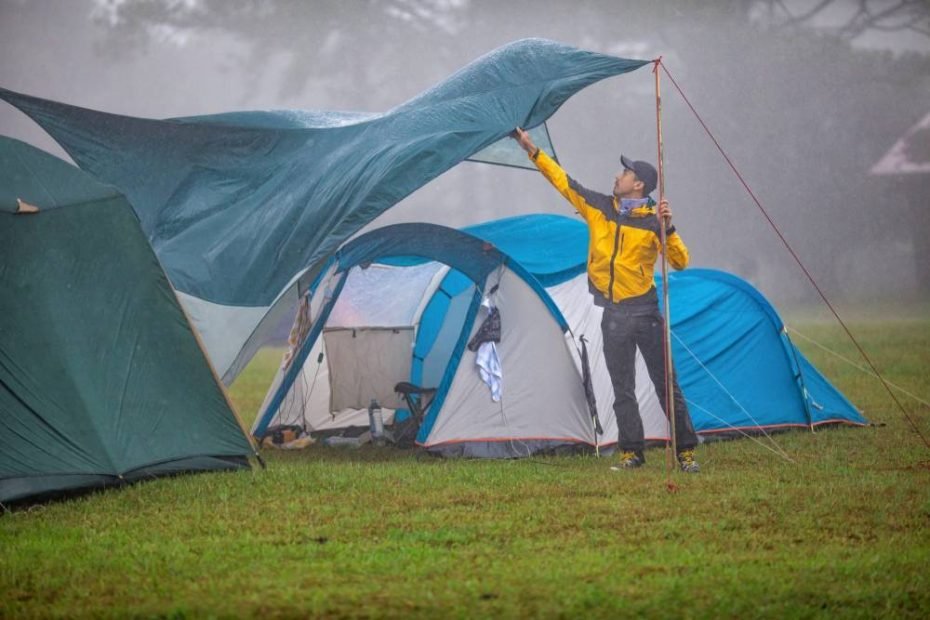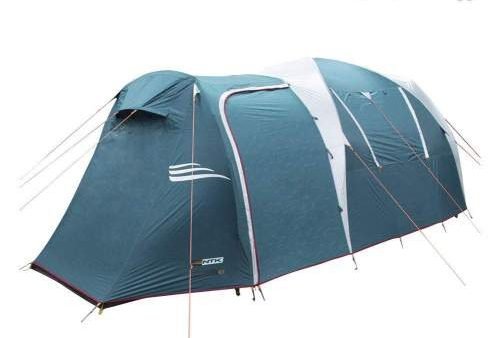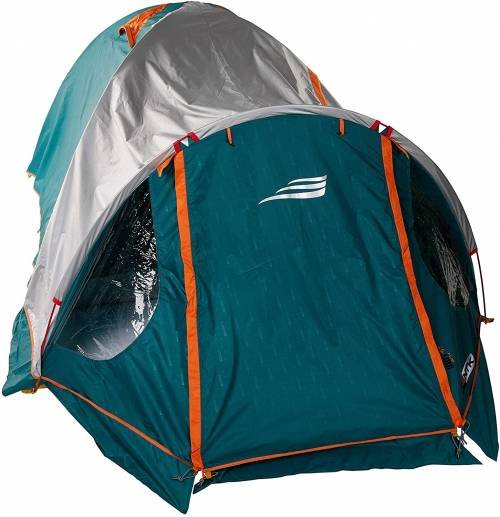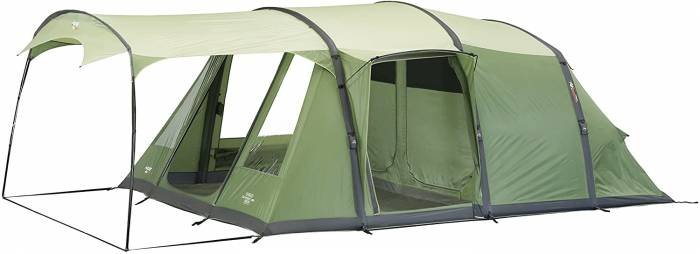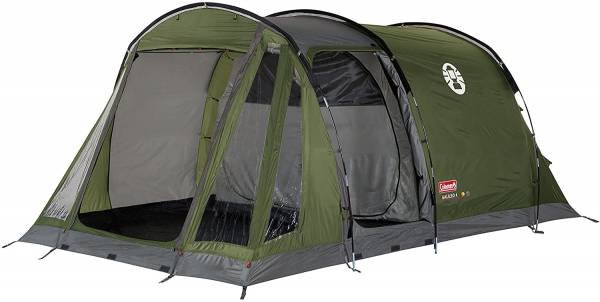With a waterproof tent for camping, you can rest assured that you’re prepared for whatever mother nature has to throw at you. Waterproof tents provide a dry outdoor shelter to prevent leaks from getting into your sleeping space. This leads to a much more comfortable experience, as you don’t need to worry about puddles forming inside your tent.
These tents can also keep you safer in terms of staying warm. If moisture seeps inside your area, it can cause the interior temperature to drop significantly. This can become a huge problem for campers, as maintaining warmth is one of the most important things when camping. In the most extreme cases, a severe drop in temperature can even lead to hypothermia.
Table could not be displayed.True waterproof models will have a water rating, otherwise known as water column or index, and make some of the best tents for camping with a high index. This rating helps to determine how well the tents hold up against different levels of rain. It’s a hydrostatic head measurement, which is usually expressed in millimetres. Anything with a rating of 1500mm and over will give you a reliable amount of protection, but of course, the higher the rating the better the protection.
So, with so many to choose from, how do you find the best waterproof tent? We’ve compiled this special list to help you break it down and find the best one for your next trip. Stay tuned for the second act of this article, which will guide you through how to waterproof a tent.
Page Contents:
10 Best Waterproof Camping Tents for All Weather
1. Quechua Waterproof Pop Up Camping Tent
Water Rating: 2000mm
First up we have this backpacking tent from Quechua. While it’s not the most lightweight on the market, weighing in at 7.30 lbs it’s great for a travelling couple. As well as a darkroom effect that blocks a large portion of sunlight, the waterproof rating tells us that it can withstand moderate to heavy rainfall, but nothing too extreme. The rainfly is PU-coated for durability, and the groundsheet is a tough 120g polyethylene (PE) material.
Setting it up is a breeze with the pop-up structure. It literally pops up out of the bag, so you don’t need to spend hours assembling it. This is a highlight feature for us because it can really come in handy if you’re stuck in bad weather and need a quick form of shelter.
Features:
- Patented Dark Rest Fabric Blocks 99% of Light
- Full Coverage Fly with Vents
- Withstands 50km/h Winds
2. Vango Waterproof Atlas 300 Outdoor Dome Tent
Water Rating: 3000mm
A huge hit with many campers, this Vango tent has a high waterproof index that will resist mild to heavier precipitation. The rainfly is all coverage, reaching down to the ground on all sides. One side makes a small vestibule, which even has a ground area as well so that your gear can’t get wet.
Other weather resistance comes from the inner bathtub flooring. It’s sewn into the floor sheet, creating a tight seal that prevents any leakage from puddles forming on the ground. In addition to being waterproof, the fabrics are fire retardant.
To ensure you’re getting enough air circulation with the fly on, it is well vented. Mesh panels on the roof and doors allow air to come through and keep you comfortable while you sleep.
Features:
- Roomy Front Vestibule for Storage
- Full Coverage Fly with Vents
- Large Carry Bag Included
3. NTK Arizona GT Sport Camping Tent
Water Rating: 2500mm
Perfect for a family camping trip, this has a capacity of 10 people which makes it ideal for a family of 4 for extra storage space. It can be difficult to find a larger capacity tent for more rough conditions, so this is a top pick for us. The set up isn’t a headache, as it uses the simple ring-and-pin system.
An extended dome shape gives it an aerodynamic quality that allows it to withstand moderate winds. Constructed of durable nano-flex fiberglass poles, the framework is shock-corded which keeps it stable. Waterproofing comes from the double layer 190T laminated polyester, that also has a PU coating. The seams are all heat sealed for increased defense against moisture, and it also protects from UV rays. A high bathtub flooring adds even more protection.
Features:
- Strong Nano-Flex Fiberglass Frame
- Meets High Standard CPAI-84 Fireproof Requirements
- Anti-Fungal Silver Coated Fabric Keeps You Dry
4. MSR Hubba Hubba NX Backpacking Tent
Water Rating: 3000mm
Next, we’re taking a look at this lightweight waterproof model from MSR. This model is available either with or without the Xtreme Waterproof Coating.
This coating lasts up to 3 times longer than standard coatings, but the one without will also withstand heavy rains. We recommend the Xtreme Coating model for those camping in extreme torrential precipitation.
Kickstand vents are a smart feature that let you get air circulation with the flysheet on. On wetter days, built-in rain gutters encourage heavy rainfall to flow off the tent more easily. Another upgrade of the Xtreme Waterproof Coating version is the addition of Easton Cyclone poles. These are made of aerospace composite materials to flex better under the force of heavy winds.
Features:
- Revolutionary Xtreme Shield Waterproof Coating Option
- Full Coverage Fly & Inner All-Mesh Roof
- Lightweight 3.5 lbs for Easy Portability
5. Geertop Portable Backpacking Tent
Water Rating: 3000mm
This 4-season waterproof model from Geertop presents versatility at its best. At a 4-person capacity, we think it’s ideal for 2 campers as there will be heaps of extra space.
The rainfly is packed with features, from the roof and ground vents, and multi-use vestibule. As well as a spot for gear storage, it can be used as an awning. Creating a porch area using your own trekking poles gives you the advantage of a larger space, with a smaller tent. You can sit underneath the shade and relax outside of the sleeping area.
In addition to the 3000mm water column of the fly, the flooring actually has a very high rating of 5000mm. This is important because the floor is a high-traffic area, so you need this added protection. 210T breathable polyester makes up the inner tent, robust 210D Oxford fabric for the floor, and 210T PU coated polyester for the fly.
Features:
- Additional Large Front Canopy
- Anti-Tear Materials
- Portable Pack Size 17.3” x 8.2”
6. NTK Indy GT XL Outdoor Dome Tent
Water Rating: 2500mm
Another sport model from NTK, this suits a family of 3 or 4 with the 6-person capacity. Connected to the traditional dome shape is the front screen room. It’s quite large and adds so much extra space. Unlike some other screen porch models, the entire structure is covered with a fly, so you can store your gear in the front room knowing that it will stay dry.
A simple set up with pole hooks, sleeve system, and ring-and-pin system leads to a very stable tent. Galvanized steel parts on the frame, as well as high-performing bungee cord guy lines create a sturdy structure that bounces back from high winds. Other materials include the PU coated polyester rainfly, an anti-mould flooring with a silver coating for insulation, and breathable micro mesh to protect from insects.
Features:
- Large Front Screen Room with Flooring
- Complete Coverage Fly with Air Vents
- Sturdy Nano-Flex Technology Frame
7. Vango Odyssey Air 600 Tent
Water Rating: 4000mm
Another edition from Vango, this tent has one of the highest waterproof ratings on our list so far. This is a premium model that sits on the more high-end scale in terms of price and quality, so it’s ideal for serious campers who go on frequent trips. Fit for 6 people, it’s optimal for a group of 3 to have the all-important storage space leftover. It’s a comfortable tent, especially since it’s made for more extreme weather conditions. It doesn’t seem to sacrifice on comfort for protection.
A classic tunnel tent, it’s built to withstand high winds. Using inflatable air beam technology, it can be pitched in around 8 minutes with practice. Plus, the air beams are pre-angled which provides more space inside and more effective bracing against winds. For even better stability in windstorms, there is the patented tension band system that can be separately attached.
The Air Zone ventilation system creates comfortable airflow, even with the fly on. Large front PVC windows bring sunlight through during the day. It offers a tall height of 79.9”, allowing people to stand up comfortably.
Features:
- Massive Front Room Area
- Aerodynamic Tunnel Shape Withstands Intense Winds
- Inflatable Poles for Easy Pitch
8. Coleman Galileo Outdoor Tunnel Tent
Water Rating: 3000mm
The Galileo tent from Coleman is popular for its rustic design and high weather resistance. It’s another hit with families, as well as couples, as it’s available in 4 or 5-person sizes. The connected front room is spacious and provides a breezy, yet protected, area for storage and relaxing. It’s also large enough for a table and chairs to enjoy a dining area away from the sleeping quarters.
Beyond the waterproof protection, this tent also has UV Guard 50+ protection, and it’s also fire retardant. Any fires will self-extinguish to keep everyone safe. In winds, a combination of the aerodynamic tunnel shape and flexible fiberglass poles ensure a high-performance response to keep it from blowing over.
A curtain divider in the back room lets you customize the space to your liking. For easy entry and exit and ventilation, the side door is large and has a screen to shield from bugs. There aren’t a lot of other screens throughout the tent, just some vents and a rear window for airflow. I would use this tent more so in mild weather, not extreme hot or cold, as you can’t control the ventilation as much.
Features:
- Roomy Front Porch with PVC Windows
- 3 Large Rooms with Divider
- Generous Amount of Space
9. Coleman Rocky Mountain Waterproof Tunnel Tent
Water Rating: 4500mm
This next one is a star pick for family car camping. As well as a comfortable living space that’s sectioned out well, the tunnel construction means it performs well in harsh weather. With such a high waterproof rating, we can see it being used for rough back country camping trips.
Starting with the front, there is a rounded awning that hangs over the door for added protection when it rains. Since there is no rainfly, the entire front entrance can close off, as well as the windows from the inside. Moving in, there is an open living area that feels super airy with the windows opened. Set up a table and chairs, and you’ll still have leftover storage space. Lastly are the back rooms. They are separated by a divider, and the standout here is that this section has blackout technology.
In terms of materials, the flooring is thick and heavy-duty, made from PE with welded corners and integrated seams. The outer fabric is made from PU coated polyester, that is also UV 50+ protective and fire retardant.
Features:
- Back Darkroom Blocks 99% of Sunlight
- Strong Fiberglass Pole Framework
- Durable Polyester Carry Bag Included
10. Vango Omega 350 Tunnel Tent
Water Rating: 5000mm
Our final pick is again from Vango, with an extended dome style that performs very well in intense winds. One of the best for 2 people, but it can easily fit up to 3, this comes in at the highest waterproof rating on our list. At 5000mm, it can withstand the heaviest of rainfall, with Protex 70D polyester for the flysheet and 70D lightweight polyester floor. In fact, the flooring has a rating of 6000mm, which will keep you very dry inside, even with large pools of water on the ground.
Made of a front room and back bedroom, the side entry door is super wide and D-shaped for simple entry and exit. All flooring has a bathtub design to prevent water splashes entering. The door to enter the back room has a large O-shape, making it easy to open with one hand. Roof vents encourage ventilation when everything is closed. To combat winds, the TBS II tension band system creates rigidity to ensure everything remains stable.
Features:
- Innovative TBS Tension System Ensures High Stability
- 5000mm Fly Water Rating & 6000mm Floor Water Rating
- Fast Pack Over-sized Carry Bag
Why Do You Need to Waterproof a Tent?
Even though there are countless tents available (like the ones on our list) that provide great watertight protection, you never know what kind of torrential rains you’re going to get while camping.
You can never do ‘too much’ when it comes to ensuring that you stay dry while living in the outdoors. It’s better to be safe than sorry, right?
Now, you don’t need to necessarily do this for every season. Many campers will do this before their first trip with a new tent, as well as throughout the lifespan of the tent – it’s certainly not just a one-time thing.
If you’ve had your tent for a few years or spend a lot of time camping in rocky or dusty areas, dirt can begin to damage the fabrics. Learning how to re-waterproof your tent is a critical skill to have in order to get the most out of it, and stay dry, safe, and protected.
How Do You Know When it’s Time to Reproof a Tent?
There is no real rule on when exactly you should repeat the waterproofing process on the tent. The frequency will all depend on many factors like:
- How often you go camping.
- The locations you use your tent.
- The surrounding environment and weather that it is regularly exposed to.
If you pack your tent as per the manufacturer’s instructions. Often, you need pack it in its bag only when it’s completely dry, and when not in use you should leave it out of the bag to breathe.
One of the best ways to tell is if the tent’s coating is visibly flaking off. Also, you can test its abilities using a few sprays of water. If you notice some soaking of the water, drips inside, or a lack of beading of water droplets, it’s time. The primary places that can leak are the seams, fabric, and rainfly.
What are the Tent Waterproofing Methods?
The 3 main ways are:
- Sealing the Seams
- Reviving the Durable Water Repellent (DWR)
- Refreshing the Urethane Coating
No matter if it’s a new tent, or you’re re-doing the process, you should follow all 3 steps. Although, you could skip out on the third method if it’s a completely brand-new tent and you don’t have tent sealant on your hands.
The urethane coating on the tent can flake off as time passes, so you probably don’t need to do it straight away.
Sealing the Tent Seams:
What you’ll need:
- A cloth
- Seam sealer
- Rubbing alcohol
Tent Seam Sealing Method:
- Set up the tent in a well-lit room so that you can see the seams clearly. It helps to put the rainfly inside-out.
- Remove any peeling parts, but don’t fully remove any sections that are undamaged.
- Prepare the seams with some rubbing alcohol. Rub on softly using the cloth.
- Apply the sealer to all the seams. Use a thin and even layer, about a millimetre thick, and use a small brush to even it out.
- Let it completely dry.
Maintaining the DWR:
What you’ll need:
- Waterproof coating spray
- Damp cloth
- Water
How to Restore your Tents DWR – Method:
- Pitch the tent so that it’s fully set up. Spray the rainfly with water, or if you’ve just washed it, you don’t need to wait for it to dry in order to apply the new coating. Remember to always use a mild soap and cool or warm water, so as to not damage the fabrics or coloring.
- Spray the waterproof coating evenly over the fly. Read instructions on the bottle to ensure you keep the bottle at a certain distance, and in case there are any additional instructions.
- After a few minutes, take your damp cloth and wipe off any excess residue of the coating.
- Make sure to always let your tent dry fully before packing it away. This will reduce the risk of mould build-up, and it will also ensure that the coating works properly.
Refreshing the Urethane Coating
What you’ll need:
- An abrasive sponge
- Tent sealant
- Rubbing alcohol
How to Refresh the Urethane Coating – Method:
- Put the rainfly and tent flat on the floor.
- Rub off any flaky bits using the sponge and alcohol.
- Spread on a thin layer of the sealant all over the fly and tent.
- Wash your hands after this process for safety.
- The coating needs to dry for a whole 24 hours (check on the bottle though).
How to Waterproof Canvas Tents, Polyester Tents, Nylon Tents?
There are 2 main types of fabrics used for tents – natural or synthetic/man made. Natural includes the most popular, canvas. Synthetic fabrics commonly used are polyester, nylon, silicone-coated, and polyethylene (PE). Polyurethane (PU) is also a common material, which you’ve probably seen labelled as “PU coated”.
Waterproofing Canvas Tents:
This type of tent needs to go through a seasoning or weathering process, even though cotton canvas is inherently impermeable. Season it as follows:
- Set up the tent, ensuring it’s straight and taut.
- Soak the entire tent in lots of water, ensuring that you cover every spot.
- Let it dry FULLY. During this process, the fibres swell and seal any micro holes within the fabric.
- Repeat the process a few times if you need a high amount of protection.
- To further make it watertight, use a fluoropolymer-based spray for acrylic canvas, and silicone-based spray for regular canvas. Follow the “Reviving the DWR” steps from above, just replace the spray with the right product.
Waterproofing Polyester, Nylon, PE, PU, Silicone Tents:
Since these are the most commonly used fabrics for tents, the above 3 methods (Sealing the Seams, Reviving the Durable Water Repellent (DWR), and Refreshing the Urethane Coating) should all be used in the waterproofing process.
For polyester, nylon, PE, and PU coated fabrics, use a water-based sealant. For silicone coated tents, a silicone-based one is the way to go
Tent Waterproofing Extra Tips
- ALWAYS use the sprays, sealants, and other chemical products in a very well-ventilated area.
- It’s crucial that you wait for the tent (no matter what material) to completely dry before storing away again.
- You may need to apply more than one coat, depending on what kind of weather you’ll be encountering or how often you’ll go camping. Wait for the first coat to dry before putting another on.
- Don’t forget the groundsheet. Always check if it’s in good condition and use a footprint where possible.
Conclusion on Waterproof Tents
Even when you’re camping in the warmer months, you can’t always predict what kind of weather you’ll get. Using one of the best waterproof tents from our list will ensure that you’re prepared for all kinds of conditions, so that you can stay dry and warm inside.
Whether you’re off on a solo adventure, or having a fun family trip, keeping things watertight is a must. Even though the water rating is typically pretty universal, there are several factors that differ between brands that will affect how impermeable a tent is.
These can include the features, materials, and whether you consider waterproofing the tent yourself as an extra step. Speaking of making a tent resistant to water, read on to discover how.
Resources and Sources
What is a Hydrostatic Head Rating
How to Waterproof Polyester Material

